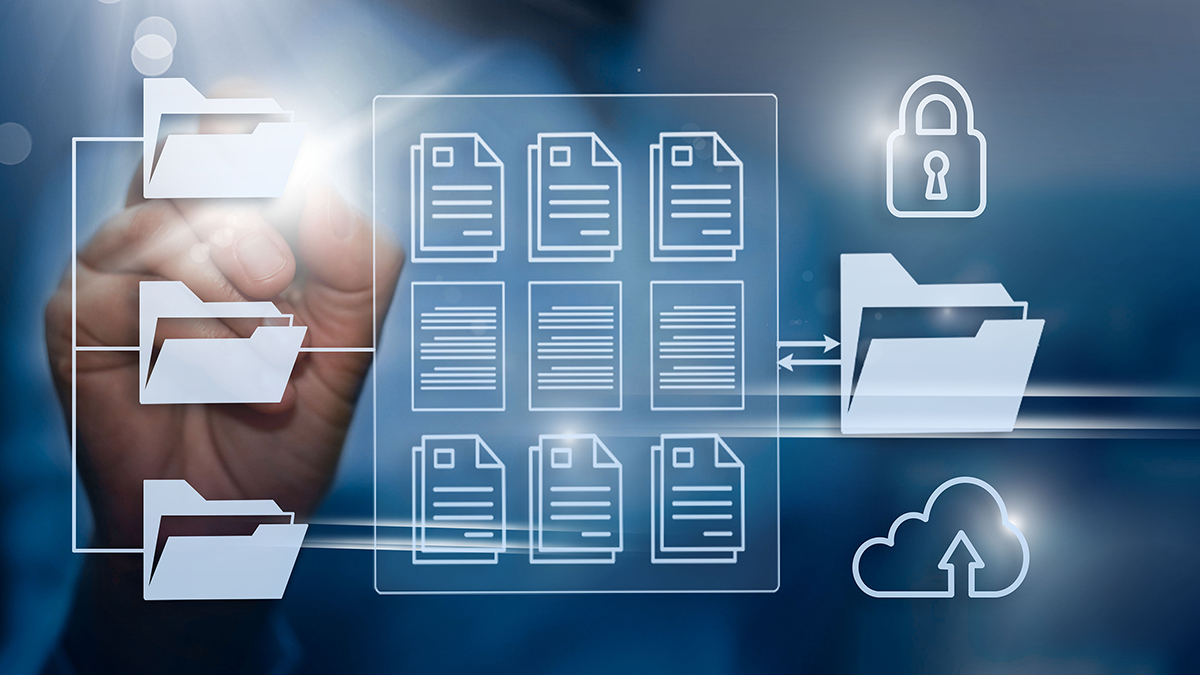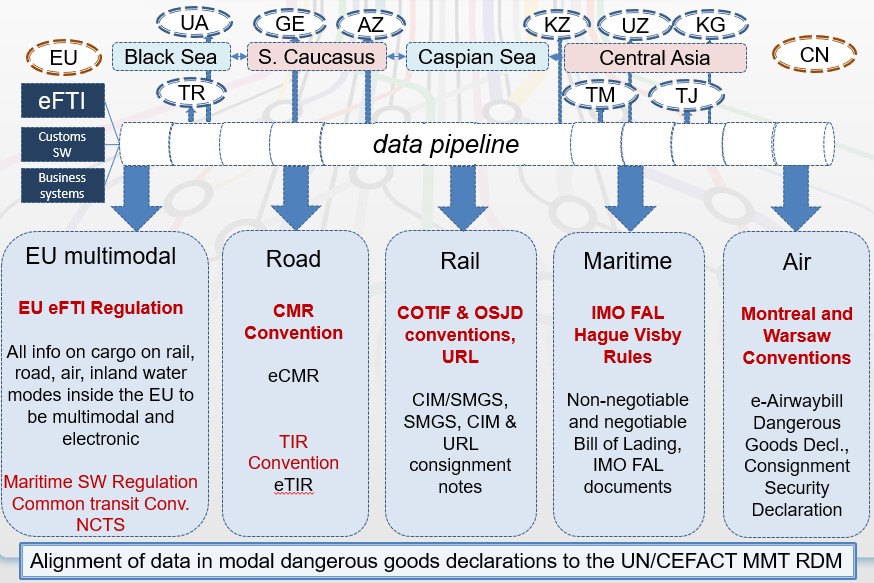Written by Mario Apostolov, Article No. 121 [UNCTAD Transport and Trade Facilitation Newsletter N°102 - Second Quarter 2024]

© Adobe Stock
The future of trade and transport facilitation is in the digital transformation of data and document exchange. If trade facilitation is defined as the simplification, standardization and harmonization of trade procedures and associated information flows along supply chains, digitalization does not necessarily relate to simplification. However, the aim of digitalization is to increase the efficiency of international trade and the economy. This would liberate significant resources for society to use for sustainable development. To achieve this, the international community needs to harmonize and standardize the digitalization of all segments in multimodal transport and supply chains.
The problem: fragmentation of digitalization efforts
There is an inherent problem in the current efforts to digitalize segments of the supply chain and trade and transport corridors. These efforts are fragmented among modal, national, and regional legal and operational regimes, syntaxes and technologies, as well as uncoordinated projects. Such a fragmentation is detrimental to trade efficiency. It is a major reason, for example, for the notorious historical inefficiency of the Trans-Caspian Corridor in comparison with the maritime route or the “northern” land route between East Asia and Europe. Vested interests only add to the problem. International trade is a complicated activity, and there have always been those who benefit from the complexity. If data is the new gold, keeping control of segments of the data flow along the supply chain is a matter of power and benefits. Data is generated in the business community, as economic agents initiate trade transactions and request trade and transport services. It is then integrated in freight forwarders’ house waybills, from where it passes to manifests, master waybills, consignment notes (for rail, road, and air), bills of lading (for maritime transportation), and dangerous goods declarations for all modes of transport. Data is thus dispersed among modes of transport, legal regimes, and segments in the supply chain.
The response: interoperability based on UN semantic standards
A possible solution is to base a seamless multimodal data and document exchange along a corridor on the use of the global semantic standards and Multimodal Transport Reference Data Model (MMT RDM) of the United Nations Centre for Trade Facilitation and Electronic Business (UN/CEFACT).[1] These are international public goods that have the potential to alleviate the wastefulness of fragmentation.
UN/CEFACT, a subsidiary intergovernmental body of the UN Economic Commission for Europe with global remit as the UN focal point for semantic standards for trade facilitation and electronic business, has decades of experience in developing standards and best practice recommendations for trade facilitation and electronic business. Its first recommendation – on the standard layout key for trade and transport documents – was published in 1973.[2] Among others, the Centre has produced and maintains the only global standard for electronic data interchange - UN/EDIFACT – a set of internationally agreed standard messages, directories, and guidelines for the electronic interchange of structured data for trade, transport, and related activities. UN/EDIFACT is widely used for hundreds of millions worth of trade transactions around the globe, including the exchange of railway consignment notes in the IFTMIN message format in broader Eurasia, including China, Central Asia, the Caucasus, Russia, and Eastern Europe. UN/EDIFACT is a perfect example of the advantages of an internationally negotiated and agreed standard, as opposed to unilaterally imposed standards by single major trading powers in the world.
Even if UN/EDIFACT is still widely used, since the 1990s, when UN/EDIFACT was first developed, the world of electronic data sharing has changed. Internet and cloud computing have made the formats for information exchange much more flexible, but also more difficult for standardization. For several decades, experts working for UN/CEFACT have developed a family of reference data models: an overarching Buy-Ship-Pay Reference Data Model; its subset reference data models for commercial documents; multimodal transport (MMT RDM); a reference data model to support interoperability with regulatory IT systems (e.g., Customs). This is the new standards foundation for digitalization of information flows along the supply chain in the age of Internet, when the world is moving from an exchange of documents (either paper or electronic) to the exchange of datasets (electronic transferable records in the terminology of the UN trade law body UNCITRAL) with all the practical, technical and legal implications that stem from it. The principles in the above approach to digitalization are that multimodal solutions are better than modal ones; global solutions are better than local ones; and existing standards (like IATA’s standard electronic airwaybill) are not replaced. This approach seeks mapping the data in each existing and new solution to the MMT RDM as the ubiquitous reference for interoperability, as a real international public good.
This is the innovative thrust of standardized digitalization of multimodal information flows in trade and cargo transportation. It revolutionizes the structure of international trade from within, destroying the fragmented one while creating a new, seamless, harmonized, and standardized exchange of digital data and documents, leading to improved efficiency and lower cost of trade.
Roadmap for multimodal digitalization in the Trans-Caspian corridor
Following this approach, in 2023, UNECE supported the development of the Roadmap for the Digitalization of Multimodal Data and Document Exchange along the Trans-Caspian Corridor using United Nations Legal Instruments and Standards.[3] It was adopted by the Presidents of the States participating in the UN Special Programme for the Economies of Central Asia (SPECA) at their summit on 24 November 2023, in Baku. The Trans-Caspian corridor receives much attention in the current geopolitical situation, and this gives a historical chance to look at the causes of inefficiency related to cargo data flows along the corridor. The roadmap supports the use of the UN/CEFACT semantic standards and MMT RDM. The European Union (EU) already uses the UN/CEFACT standards as a key reference for interoperability in the implementation of the EU 2020/1056 Regulation on Electronic Freight Transport Information (eFTI).[4] In this sense, two important sub-regions will be linked through the same semantic foundation for multimodal data and document exchange.
Cargo transported along the Trans-Caspian corridor switches from inland transportation (rail or road) in Central Asia to maritime mode in the Caspian (under IMO law and IMO standardized documentation), inland mode in the South Caucasus, maritime mode in the Black Sea, and inland mode in Türkiye, Ukraine, and the European Union. The need to invest in infrastructure is an important and unavoidable burden for that corridor. Yet the soft part of the operation - the harmonization and standardization of multimodal digital exchange of information about cargo, namely the road, rail, and air consignment notes and maritime bills of lading and additional documents – is a low-hanging fruit with huge potential to improve efficiency. Cargo cannot move faster than the information about it, as control agencies and business partners need information to let goods move on. The UN standards become very useful to provide interoperability and a seamless flow of information along the data pipeline of the digital corridor.
Digitalization of data and document exchange using the package of UN/CEFACT standards for multimodal data and document exchange creates a seamless flow of information on cargo transported through digital corridors. This can serve as the foundation for building a data pipeline along such trade and transport corridors as the Trans-Caspian one. Standards for digital data and document exchange would help harmonize digitalization efforts across various legal regimes (see Figure 1).
Figure 1: Information chain on cargo movement in a digital Trans-Caspian corridor

Source: The author
UNECE and partners are working now on training experts to use the UN/CEFACT standards in digitalization efforts along the corridor and rolling out pilot implementation projects. An example of such a pilot project is the testing of an electronic equivalent of the CIM/SMGS railway consignment note along the Trans-Caspian corridor, implemented in partnership with the Permanent Secretariat of the Intergovernmental Commission of the Transport Corridor Europe – Caucasus – Central Asia (TRACECA), specialized railway organizations in the region, and five national railway agencies. Currently, an electronic equivalent of the railway consignment note, prepared with reference to the UN/CEFACT standards, is being tested. This involves initiating an e-document exchange by filling in the railway consignment note in the country of departure and sending it further along the cargo information chain, and receiving party confirming the arrival, checking for errors, and sending either an error message or a validation receipt. The broader advantage of using UN/CEFACT standards is the link to multimodal and cross-sectoral interoperability of data exchange about cargo in a multimodal transport operation.
[1] https://unece.org/trade/uncefact/mainstandards
[2] https://unece.org/trade/uncefact/tf_recommendations
[3] Available at https://unece.org/speca/speca-digitalization-roadmap
[4] See https://eur-lex.europa.eu/EN/legal-content/summary/electronic-freight-transport-information.html
Contact the author:
Mario Apostolov | Regional Adviser | UNECE Economic Cooperation and Trade Division | Mario.Apostolov@un.org



